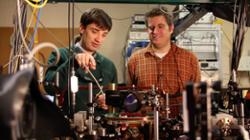Michael Ray, a visiting assistant professor of physics, is part of a team of international collaborators that have experimentally identified a point-like monopole in a quantum field for the first time.
The discovery, announced this week, gives scientists further insight into the elusive monopole magnet, an elementary particle that researchers believe exists but has not yet been seen in nature.
The development — explored in a paper published in Science – is a remarkable step forward in quantum research. A better understanding of the structure of monopoles and other topological entities is very valuable to scientists, in part because they appear in the models describing the first moments of the universe’s existence and affect the properties of many different materials, such as metals.
“This was a very exciting experiment to perform,” said Ray, the lead author of the paper. “These kinds of defects are relevant to theories that describe the early universe, so observing this monopole gives us a glimpse into those moments but on a much more accessible scale.”
Working with Amherst College physics professor David S. Hall, his post-doctorate advisee, Ray manipulated a gas of rubidium atoms prepared in a nonmagnetic state near absolute zero temperature in an atomic refrigerator in Hall’s lab. Under these extreme conditions, they were able to create monopoles in the quantum field of the ultracold gas.
“In this nonmagnetic state, a structure was created in the field describing the gas resembling the magnetic monopole particle as described in grand unified theories of particle physics,” said Aalto University (Finland) Academy Research Fellow Mikko Möttönen, a collaborator on the team who led the theoretical analysis of the monopole.
“Previously, we have used the gas to detect a monopole within a so-called synthetic magnetic field, but there has been no monopole in the quantum field describing the gas itself. Now we have finally witnessed the quantum-mechanical monopole.”
Ordinarily, magnetic poles come in pairs: each magnet has both a north pole and a south pole. As the name suggests, however, a magnetic monopole is a magnetic particle possessing only a single, isolated pole—a north pole without a south pole, or vice versa. Despite extensive experimental searches, in everything from lunar samples (moon rock) to ancient fossilized minerals, no observation of a naturally occurring magnetic monopole has yet been confirmed.
In this case, the gas is in a nonmagnetic state, and no quantum whirlpools or monopoles are created in the synthetic magnetic field, Möttönen continued. However, quantum-mechanical magnetic order prevailed in the sample itself, and the team was able to manipulate it with adjustments to an externally applied magnetic field to generate the quantum-mechanical monopoles.
“In the experiment, the control of those magnetic fields must be stable to a small fraction of the size of the Earth’s magnetic field,” said Hall. “The main experimental challenge we faced was to prepare the ultracold gas under highly sensitive conditions, in which field fluctuations due to the motion of metal objects or power-line variations can make observation of the monopoles difficult.”
The material is based upon work supported by a grant from the National Science Foundation.
Ray joined Union in the fall. At the end of the academic year, he will join the faculty at Sacramento State University.
